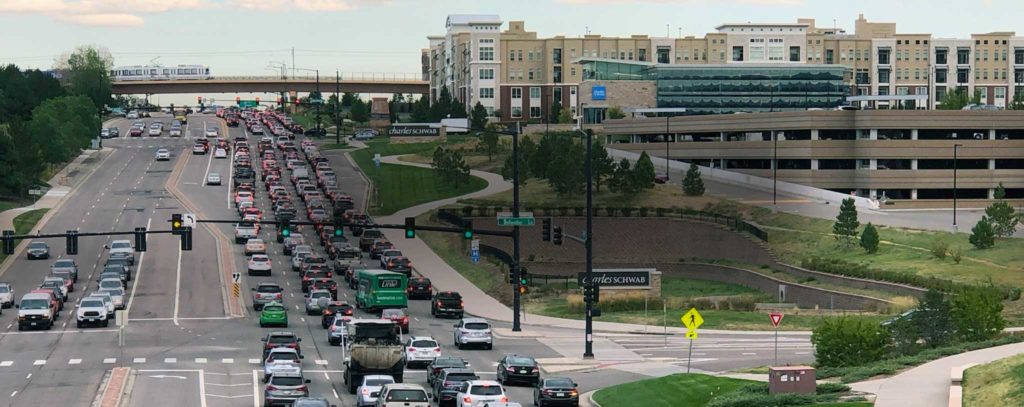Winter 2024/2025
After the proposed action design alternative was shared with the public during an open house meeting on Oct. 26, 2023, project team members continued meeting with representatives from the Federal Highway Administration and Colorado Department of Transportation to discuss this alternative in greater detail.
These meetings continued throughout 2024 and led to the recommendation to conduct an independent design review workshop to look closer at the proposed action. This workshop provided the chance for CDOT, FHWA, Douglas County, Lone Tree and four independent consultant reviewers to closely examine traffic movements and safety elements associated with the proposed action.
The outcome of this independent design review workshop conducted in August 2024 has led to some significant project updates. The overall recommendation coming out of the workshop is to not move forward with the proposed southbound I-25 to eastbound Lincoln Avenue flyover ramp. Citing geometric challenges and safety concerns associated with the public’s ability to safely navigate the flyover ramp connection to Lincoln Avenue, workshop participants recommended removing the flyover from the project. Lone Tree and Douglas County agreed with this recommendation.
The project team is now turning their attention to advancing a series of smaller, independent projects along the Lincoln Avenue corridor to improve mobility between Park Meadows Drive and Oswego Street. Based on recommendations from the workshop, efforts moving into 2025 will focus on:
Advancing multimodal design plans. This includes the potential for grade separated bicycle/pedestrian facilities over I-25 and ramp crossings and providing connections to the Lone Tree Mobility Hub on both sides of I-25 south of Lincoln Avenue.
- Developing short-term and long-term solutions for improving traffic flow through the Havana Street intersection.
- Refining current intersection operations at Park Meadows Drive, I-25 interchange ramp terminals, Zenith Meridian Drive, and Oswego Street to improve traffic flow and safety along Lincoln Avenue.
- Meeting with the project’s leadership and technical committees and other major stakeholders to continue moving the project forward as potential grant opportunities arise.
This work will be fast-tracked in early 2025 and culminate with a public meeting before starting the National Environmental Policy Act (NEPA) process on selected improvements…
Spring 2023
Since the last public meeting in March 2023, the project Leadership Committee has accepted the Technical Committee’s recommendation to advance Alternative 1B to the next stage of the project. Additional details are provided below.
- Alternative 1B is now referred to as the Recommended Alternative and will progress through preliminary design
- Preliminary design includes but is not limited to:
- advancement of vertical and horizontal geometry for roadway and structures
- advancement of overall project design to support NEPA process and assessment of impacts
- data collection and evaluation of utilities
- data collection and evaluation of geotechnical
- data collection and evaluation of drainage
- determination of right-of-way needs
- Evaluation of the Recommended Alternative through the NEPA process
- NEPA process includes but is not limited to:
- confirmation of project purpose and need
- data collection and evaluation of environmental and socio-economic resources
- assessment of Recommended Alternative for potential to impact environmental and socio-economic resources
- assessment of mitigation requirements for impacts, including natural and built environment
- evaluation of project phasing opportunities, including potential funding scenarios for construction
- NEPA process results in a Decision Document approved by CDOT and FHWA
- Continued coordination with CDOT regarding the Lone Tree Mobility Hub (currently under design through CDOT) and the two project teams will coordinate to ensure seamless integration of both projects.
- Continued coordination with all engaged agencies and stakeholders through the Technical and Leadership Committees
- Continued public involvement with the next public meeting anticipated in Fall 2023
- Project schedule updated to reflect completion of NEPA and preliminary design in Spring 2024
Summer 2022

Since the first public meeting in November 2021, the following activities have been ongoing:
- Data collection and analysis of traffic and safety elements, including traffic counts, crash data, and development of the traffic model.
- Data collection and analysis of survey, environmental and multimodal information.
- Development of the project’s Purpose and Need statement to help guide decision-making in the alternatives screening process.
- Development of evaluation criteria to support all levels of alternatives screening and recommendations for alternatives to move forward.
- Coordination and meetings with various stakeholders along the project corridor to gather input on improvement needs and existing data to support analyses. Input has been gathered from:
- Adjacent property owners
- Local developers and property managers
- Local elected representatives
- Douglas County and Lone Tree transportation and planning staff
- Federal Highway Administration (FHWA) and Colorado Department of Transportation (CDOT)
- Mobility advocates like the Regional Transportation District (RTD), Denver Regional Council of Governments (DRCOG), and Denver South
- Monthly meetings with the project’s Technical Committee (TC), comprised of technical experts from numerous agencies and stakeholders. The TC will develop, evaluate, and screen design alternatives at the I-25 interchange and the Havana intersection, eventually providing recommendations for what alternatives to move forward through the screening process.
- The project schedule (provided on website homepage) has been extended to ensure that relevant and applicable data is collected and analyzed, and that the project’s management team has adequate time to coordinate with stakeholders throughout the decision-making process. This is key to ultimately selecting a recommended alternative for the project.
